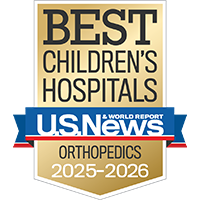Learning never stops
Our classroom and bedside classes help kids get credit and keep learning during treatment.
See our school program

Femoral anteversion is an inward twisting of the femur (the thigh bone), which causes the knee and toes to also turn inward. It's congenital (present at birth) and often affects both legs. The opposite condition, femoral retroversion, is when the femur rotates outward.
Femoral anteversion is common, and most children outgrow it by adolescence without any treatment. Rarely, the condition persists and affects how the child walks. When this happens, surgical correction is available.

Ranked among the nation's best in 11 specialties

One of the nation's best for orthopedics
Femoral anteversion may result from the baby's position while growing in the uterus. It tends to run in families, and females are about twice as likely as males to be affected.
Signs of femoral anteversion in children include:
These traits can also be signs of other health issues, so your child should see a doctor for evaluation and diagnosis.
Femoral anteversion usually isn't painful. But if your child also has external tibial torsion – meaning the shin bone (tibia) rotates outward – the combination can cause knee pain.
Most kids are diagnosed between the ages of 3 and 6 with a physical exam, in which the doctor assesses the range of motion in the hips. X-rays or other imaging tests generally aren't needed.
In most cases, femoral anteversion gradually improves on its own and has resolved by about 11 years of age. Most kids therefore need no treatment. Physical therapy and supportive devices – such as shoe inserts, braces and splints – don't improve femoral anteversion, and sitting in the "W" position doesn't make it worse. Also, having femoral anteversion as a child doesn't increase the risk of developing osteoarthritis or other orthopedic issues as an adult, even if the condition persists.
If femoral anteversion doesn't go away in the usual time frame and is having a negative effect on your child, surgery may be an option.
The only effective treatment for femoral anteversion is a surgical procedure called femoral derotation osteotomy. It's performed by a pediatric orthopedic surgeon. During the procedure, the surgeon cuts the femur, rotates it into proper alignment, and reattaches the bone in the hip socket.
Surgery is generally reserved for older kids (past the age of 10) who still have a significant degree of femoral anteversion causing an awkward gait (manner of walking) and frequent tripping.
This information is for educational purposes only and is not intended to replace the advice of your child's doctor or other health care provider. We encourage you to discuss any questions or concerns you may have with your child's provider.
Learning never stops
